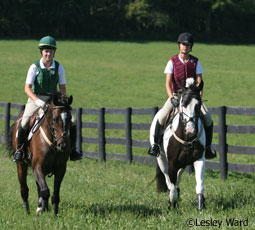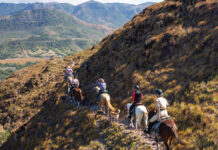
If you spend a lot of time riding your favorite horse in an arena, you should go on a trail ride every once in a while. Horses get bored and rank going round and round in circles, and they need a break from schooling. Trail riding is a great way to perk up a lazy lesson horse or energize a slow-poke jumper. Going up and down hills, stepping through mud and popping over a log or two is a learning experience for your horse. Trail riding teaches an arena horse to be surefooted and brave.
But, before you head out into the wilderness, here are a few safety suggestions to help you stay safe on the trail.
Ride with a friend
If you haven’t been out on many trail rides or you have a green horse or pony, ask a friend with a quiet, older horse to go out with you. Your horse will be calmer if he’s walking with a bombproof horse—and you’ll feel more confident too! If you don’t know the trails very well, make sure your riding partner knows where she’s going.
Before you set off on your ride, let your barn owner, trainer or parents know where you’re going and when you think you’ll be back.
If you’re riding in a park, pick up a map to help you find your way around.
Carry a cell phone
Everyone who heads out on a trail should carry a cell phone. Clip it to the waistband of your breeches or to your tall boots. Don’t clip it to the D-rings on your saddle. Why? If you and your horse part ways after a fall, the cell phone won’t help you much!
Always wear a helmet when you trail ride. Even if you ride a quiet horse, he could stumble and toss you to the ground.
Follow the leader
It’s important that your horse is happy to lead or follow on the trail. It’s very annoying to ride a horse that’s jigging and behaving badly because he hates being in the rear. Even if your horse likes leading the group, he must learn how to follow other horses.
When you go on a trail ride, switch places every once in a while. You lead for a bit and then let your friend lead for a bit. If your horse makes a fuss, turn him in 10-meter circles until he’s calm again and then let him follow his friend. If he still acts up, continue riding in small circles while your friend waits for you ahead. Don’t follow too closely though. Keep about a horse length or two between you.
Practice riding side by side as well. Pay attention to your horse’s behavior at first. If he seems grumpy or acts like he wants to bite or kick your friend’s horse, take a firmer hold on the reins and ask him to walk forward briskly. He should pay attention to your cues—not the other horse. When he calms down, loosen the reins slightly and let him relax.
Bring a hoof pick
It’s a good idea to bring a hoof pick with you when you trail ride. You can tie it to a D-ring on your saddle or slip it in a pocket. You can buy a hoof pick which folds up so it doesn’t take up as much room. Sometimes a horse will step on a rock and it will get stuck in his hoof making him seem lame.
If your horse suddenly seems sore out on the trail, hop off in a safe place and ask your friend to hold his reins so he doesn’t wander off. Then pick up his hooves to see if you spot a rock. If you see a rock wedged into his hoof, your hoof pick will come in handy.
Grass grabbing
Some horses think that a trail ride is an opportunity for non-stop snacking. They act like they’re starving and constantly grab at tasty grass and leaves! Not only is this habit annoying, because a grabber will pull out your arms, but it can be dangerous too because your horse is not paying attention to you.
If your horse is a grass grabber, ride him with a shorter reins and pay attention to what he’s doing. If he starts to move his head towards a tasty leaf or grass, tug on one rein to get his attention back and give him a small kick with both feet to ask him to move forward.
If he gets his head down, lean back slightly and tug on one rein and then the next to ask him to lift up his head.
If you’re not strong enough to get your horse’s head up, ask your trainer or a horsey parent to make “grass reins” out of twine to help prevent your horse from grazing on the trail. Simply tie twine to the D-ring at the front of the saddle, run it through the loops on each side of his brow band and down to the bit. Make sure the reins are not too tight. Your horse should be able to stretch his neck out normally, but not enough to put his head down to eat.
Spooky stuff
Don’t freak out if your horse spooks at something on the trail. Stay calm. Don’t punish him for spooking, because this could make him more upset. Let him look at the scary object for a moment and then ask him to walk by it. If he won’t walk by it, wait a few seconds and then ask him to move towards it.
Keep a firm hold on the reins in case he bolts, and encourage him forward with your voice and legs. Praise him if he moves forward a step or two. Let him sniff the scary monster for a few seconds, then ask him to walk around it. Then walk him by it several times. Once he realizes that it’s not going to pop up and attack him, he’ll probably walk by it sensibly.
This article originally appeared in the January/February 2009 issue of Young Rider Magazine. Click here to subscribe.






Good advice.